When buying a replacement fuse, you need to be able to correctly identify the fuse.
Generally the manufacturer's brand name and the actual part number should be enough to identify the right fuse.
Unfortunately, this information is not always provided on the fuse, so this guide will help you to interpret the
information that you might find on the fuse.
When examining the fuse, don't forget to look for markings on the metal caps as they are
often stamped with important information about the fuse.
Learn more about fuse markings.
Our staff have years of expertise in identifying fuses and suitable equivalents.
If you are unable to find the fuse you require, please contact our friendly staff for assistance.
How to Identify a Fuse
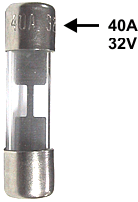
Example of a fuse with
markings on the metal cap.
How to Identify the Fuse Manufacturer & Part Number?
There are many different fuse manufacturers and each manufacturer can have different fuse brands. Hopefully the part number will be quite obvious on the fuse, but it can sometimes be difficult to identify or there may not be a part number on the fuse. If you can't identify the part number, you will need to rely on other methods of identification. It is common for the part number to include the actual ampere rating of the fuse.
There are many different fuse manufacturers and each manufacturer can have different fuse brands. Hopefully the part number will be quite obvious on the fuse, but it can sometimes be difficult to identify or there may not be a part number on the fuse. If you can't identify the part number, you will need to rely on other methods of identification. It is common for the part number to include the actual ampere rating of the fuse.

Example of a Bussmann Fuse.
Part Number: NSD20
What is the Fuse Ampere Rating?
The ampere rating is almost always shown on the fuse and is usually expressed in amperes (eg. 10A or 0.5A), but it could also be expressed in milliamps (eg. 100mA). Sometimes the ampere rating is incorporated into the fuse part number eg. FNQ-5, which is a 5A fuse.
Important: Do not confuse the ampere rating with the interrupting rating of the fuse.
The ampere rating is almost always shown on the fuse and is usually expressed in amperes (eg. 10A or 0.5A), but it could also be expressed in milliamps (eg. 100mA). Sometimes the ampere rating is incorporated into the fuse part number eg. FNQ-5, which is a 5A fuse.
Important: Do not confuse the ampere rating with the interrupting rating of the fuse.
This is a 5A fuse.
What is the Fuse Voltage Rating?
The voltage rating is usually shown on the fuse and is expressed in Volts.
Fuses are usually rated for either voltage AC (eg. 250VAC) or voltage DC (eg. 32VDC). A fuse should only be used in a circuit that matches its voltage specifcation ie. AC rated fuses should only be used in AC circuits, DC rated fuses should only be used in DC circuits.
However, some fuses are rated for both AC & DC voltages (eg. 600VAC/450VDC) and designed to function correctly in either.
Electrical symbols are sometimes used to specify if the voltage is AC or DC.
The sample fuse on the right uses the AC Voltage symbol to identify the 500V rating is for VAC. This fuse can be used in a circuit operating at 500VAC or less. It is not designed for use in a circuit operating above 500VAC.

The voltage rating is usually shown on the fuse and is expressed in Volts.
Fuses are usually rated for either voltage AC (eg. 250VAC) or voltage DC (eg. 32VDC). A fuse should only be used in a circuit that matches its voltage specifcation ie. AC rated fuses should only be used in AC circuits, DC rated fuses should only be used in DC circuits.
However, some fuses are rated for both AC & DC voltages (eg. 600VAC/450VDC) and designed to function correctly in either.
Electrical symbols are sometimes used to specify if the voltage is AC or DC.
The sample fuse on the right uses the AC Voltage symbol to identify the 500V rating is for VAC. This fuse can be used in a circuit operating at 500VAC or less. It is not designed for use in a circuit operating above 500VAC.

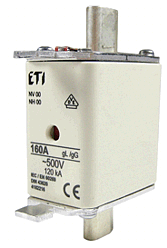
This fuse is rated 500VAC.
What is the Element Speed of the Fuse?
The speed of the fuse is usually documented on the fuse but can be tricky to identify.
Small fuses generally identify the element speed using markings such as F, M, T etc, whilst larger fuses identify the element speed using markings such as gL, gG, aM etc.
Some fuses use terms such as slow acting, fast acting, motor rated etc.
Fuses with no element speed marking require a manufacturer part number and datasheet to determine the speed of the fuse.
The speed of the fuse is usually documented on the fuse but can be tricky to identify.
Small fuses generally identify the element speed using markings such as F, M, T etc, whilst larger fuses identify the element speed using markings such as gL, gG, aM etc.
Some fuses use terms such as slow acting, fast acting, motor rated etc.
Fuses with no element speed marking require a manufacturer part number and datasheet to determine the speed of the fuse.

Type gG element.
What are the Fuse Dimensions?
Accurate fuse dimensions are often very important when trying to identify a fuse. There are thousands of fuses that have similar dimensions, so you need to be precise when measuring the fuse.
Use our Size Guide to search for fuses using dimensions.
Accurate fuse dimensions are often very important when trying to identify a fuse. There are thousands of fuses that have similar dimensions, so you need to be precise when measuring the fuse.
- Cartridge Fuses:
Measure the overall length of the fuse and the diameter of the caps. - Bottle Fuses:
Measure the overall length of the fuse and the diameter of both caps as the often vary in size. - Blade Fuses:
Require multiple measurements as per the sample schematic;- Measure the overall length of the fuse (D)
- Measure the fuse body length & diameter (A & B)
- Measure the fixing centre (G)
- Measure the fixing hole size (J & H)
- Measure the tag/blade width and thickness (E & F)
Use our Size Guide to search for fuses using dimensions.

How to measure a cartridge fuse.

How to measure a bottle fuse.
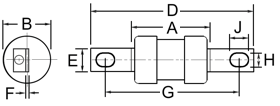
How to measure a blade or tag fuse.
What are the Distinguishing Features of the fuse?
- What material is the fuse body (eg. glass, plastic or ceramic etc.)?
- Does the fuse feature trip or blown fuse indication features?
- Does the fuse have a microswitch fitter?
- What is the body style of the fuse?
- What material is the fuse body (eg. glass, plastic or ceramic etc.)?
- Does the fuse feature trip or blown fuse indication features?
- Does the fuse have a microswitch fitter?
- What is the body style of the fuse?
- Surface Mount (SMD) or Printed Circuit Board (PCB) Mount Fuses
- Cartridge or Bottle Fuse
- Blade/Metal Tag Type Fuses (Bolt Down Mounting):
- Do the metal tags project from the centre or base of the fuse?
- Do the metal tags have mounting holes or slots?
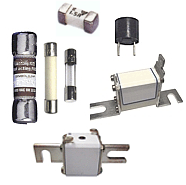
An assortment of cartridge, SMD,
PCB and tag type fuses.
What is the Interrupting Rating (I.R.) of the Fuse?
The interrupting rating or breaking / rupturing capacity of a fuse is usually documented in amperes eg. 50kA, however on some small cartridge fuses, the interrupting rating is represented by a marking eg. L or H. This information may be required when searching for an equivalent fuse of another brand.
The interrupting rating will be higher than the ampere rating of the fuse.
The interrupting rating or breaking / rupturing capacity of a fuse is usually documented in amperes eg. 50kA, however on some small cartridge fuses, the interrupting rating is represented by a marking eg. L or H. This information may be required when searching for an equivalent fuse of another brand.
The interrupting rating will be higher than the ampere rating of the fuse.
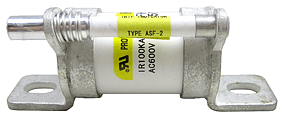
This fuse has an I.R. rating
of 100kA (100,000 Amps).
What are the Approval Markings on the fuse?
Most fuses built by quality approved manufacturers will feature one or more quality approval markings. These markings demonstrate the fuse complies with the requirements of the agency that is listed eg.UR (Underwriter Laboraties Recocnized).
Most fuses built by quality approved manufacturers will feature one or more quality approval markings. These markings demonstrate the fuse complies with the requirements of the agency that is listed eg.UR (Underwriter Laboraties Recocnized).

This fuse features
UR Approval marking.
 |
Want to know more? View all fuse tutorials. |




